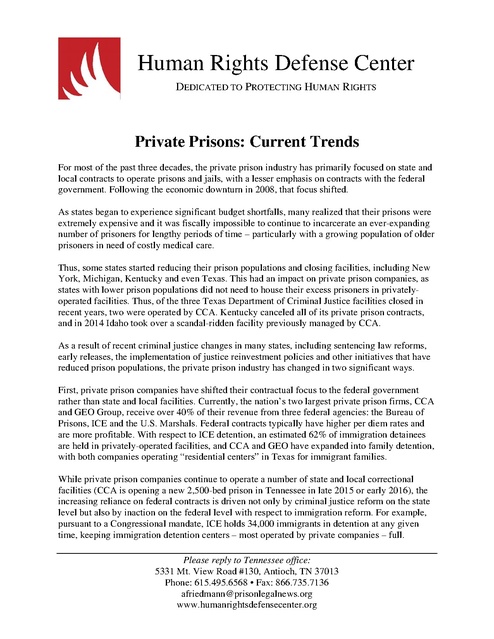HRDC Private prison fact sheet - Current trends 2015
Download original document:

Document text

Document text
This text is machine-read, and may contain errors. Check the original document to verify accuracy.
Human Rights Defense Center DEDICATED TO PROTECTING HUMAN RIGHTS Private Prisons: Current Trends For most of the past three decades, the private prison industry has primarily focused on state and local contracts to operate prisons and jails, with a lesser emphasis on contracts with the federal government. Following the economic downturn in 2008, that focus shifted. As states began to experience significant budget shortfalls, many realized that their prisons were extremely expensive and it was fiscally impossible to continue to incarcerate an ever-expanding number of prisoners for lengthy periods of time – particularly with a growing population of older prisoners in need of costly medical care. Thus, some states started reducing their prison populations and closing facilities, including New York, Michigan, Kentucky and even Texas. This had an impact on private prison companies, as states with lower prison populations did not need to house their excess prisoners in privatelyoperated facilities. Thus, of the three Texas Department of Criminal Justice facilities closed in recent years, two were operated by CCA. Kentucky canceled all of its private prison contracts, and in 2014 Idaho took over a scandal-ridden facility previously managed by CCA. As a result of recent criminal justice changes in many states, including sentencing law reforms, early releases, the implementation of justice reinvestment policies and other initiatives that have reduced prison populations, the private prison industry has changed in two significant ways. First, private prison companies have shifted their contractual focus to the federal government rather than state and local facilities. Currently, the nation’s two largest private prison firms, CCA and GEO Group, receive over 40% of their revenue from three federal agencies: the Bureau of Prisons, ICE and the U.S. Marshals. Federal contracts typically have higher per diem rates and are more profitable. With respect to ICE detention, an estimated 62% of immigration detainees are held in privately-operated facilities, and CCA and GEO have expanded into family detention, with both companies operating “residential centers” in Texas for immigrant families. While private prison companies continue to operate a number of state and local correctional facilities (CCA is opening a new 2,500-bed prison in Tennessee in late 2015 or early 2016), the increasing reliance on federal contracts is driven not only by criminal justice reform on the state level but also by inaction on the federal level with respect to immigration reform. For example, pursuant to a Congressional mandate, ICE holds 34,000 immigrants in detention at any given time, keeping immigration detention centers – most operated by private companies – full. Please reply to Tennessee office: 5331 Mt. View Road #130, Antioch, TN 37013 Phone: 615.495.6568 • Fax: 866.735.7136 afriedmann@prisonlegalnews.org www.humanrightsdefensecenter.org The second recent trend with respect to the private prison industry is diversification. Whereas previously companies like CCA and GEO Group only operated secure correctional facilities, they are now moving into other criminal justice areas. In 2011, GEO Group acquired B.I., Inc., one of the nation’s largest providers of electronic GPS monitoring. CCA purchased Correctional Alternatives, Inc., which provides community corrections services, in 2013, and the following year the company announced it would focus on rehabilitation and reducing recidivism. This diversification into community/reentry programs and services indicates that both CCA and GEO Group realize they can’t solely rely on private prison contracts to operate secure facilities, and they are therefore transitioning into other criminal justice areas. Indeed, the private prison population in the United States has remained fairly static in recent years with only small growth, and CCA has a number of vacant or partially-vacant facilities due to contract losses. Although not yet a trend, one other recent development is worth noting: Basing private prison contract performance on reductions in recidivism rates. In 2013, Pennsylvania officials announced they would provide financial incentives to privatelyoperated community corrections facilities – halfway houses – that are able to reduce recidivism rates of released offenders. The initiative followed a report that found high recidivism rates in the state, with prisoners released from halfway houses (most of which are privately-operated) having higher rates than those released directly from prison. An average recidivism rate based on data from the report is used as a baseline, and privately-operated halfway houses must meet the baseline rate within a certain range or risk losing their contracts. Those that achieve rates lower than the baseline can receive a financial bonus of one percent of the contract amount. The DOC’s community corrections contracts were rebid in 2013 to include the recidivism rate performance measure provisions. The initial performance measure period was based on data for an abbreviated three-month span, and the state’s approximately 40 privately-operated halfway houses achieved an average 16.4% reduction in the benchmark recidivism rate during the initial measure period. The second recidivism measure results, covering a year and released in August 2015, found that overall recidivism at privately-operated halfway houses was reduced by 11.3%, and six of the state’s 42 halfway houses qualified to receive a per diem rate bonus. Similarly, in early 2015, news reports indicated that a private prison in Australia would operate under a contract that provides a financial bonus if the facility can reduce recidivism rates. The 1,000-bed Ravenhall prison will be constructed and operated by the GEO Consortium, which includes GEO Group Australia.

